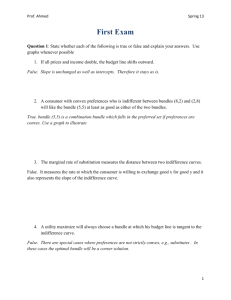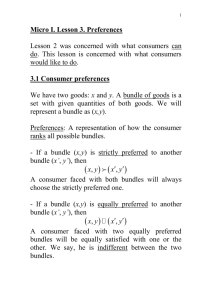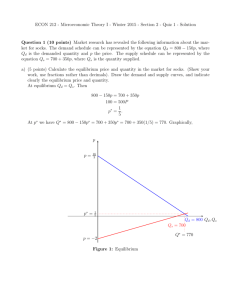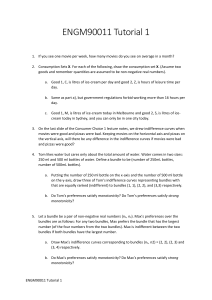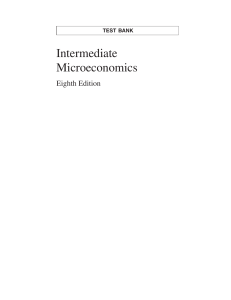EC202-Presessional Classes September 29, 2014
advertisement
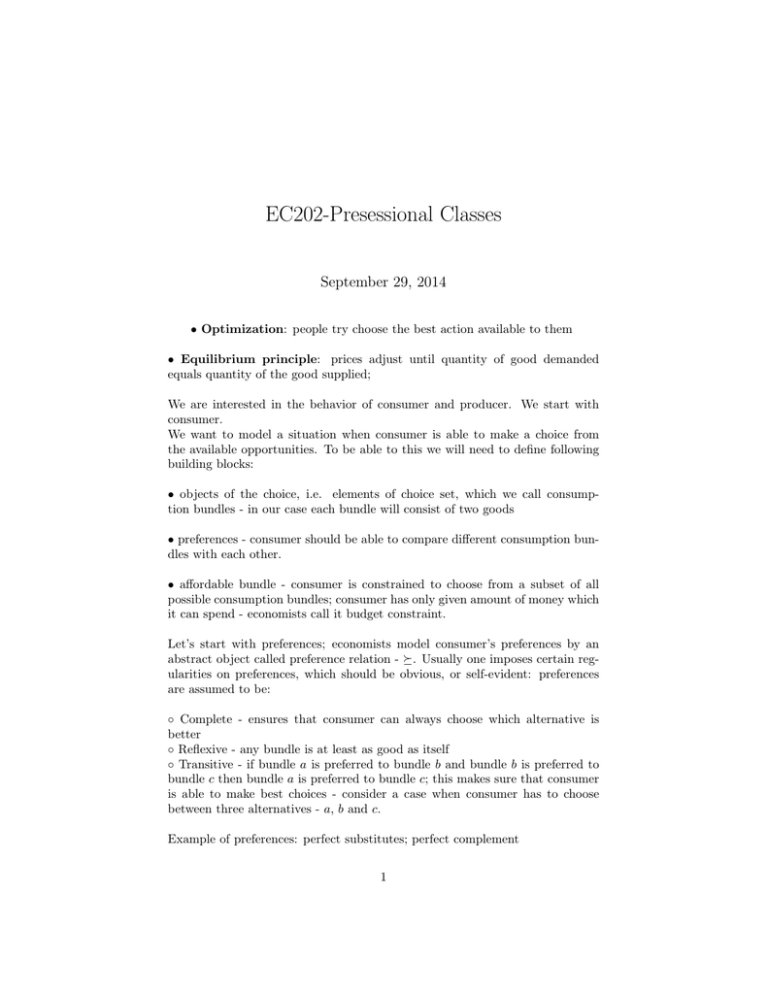
EC202-Presessional Classes September 29, 2014 • Optimization: people try choose the best action available to them • Equilibrium principle: prices adjust until quantity of good demanded equals quantity of the good supplied; We are interested in the behavior of consumer and producer. We start with consumer. We want to model a situation when consumer is able to make a choice from the available opportunities. To be able to this we will need to define following building blocks: • objects of the choice, i.e. elements of choice set, which we call consumption bundles - in our case each bundle will consist of two goods • preferences - consumer should be able to compare different consumption bundles with each other. • affordable bundle - consumer is constrained to choose from a subset of all possible consumption bundles; consumer has only given amount of money which it can spend - economists call it budget constraint. Let’s start with preferences; economists model consumer’s preferences by an abstract object called preference relation - . Usually one imposes certain regularities on preferences, which should be obvious, or self-evident: preferences are assumed to be: ◦ Complete - ensures that consumer can always choose which alternative is better ◦ Reflexive - any bundle is at least as good as itself ◦ Transitive - if bundle a is preferred to bundle b and bundle b is preferred to bundle c then bundle a is preferred to bundle c; this makes sure that consumer is able to make best choices - consider a case when consumer has to choose between three alternatives - a, b and c. Example of preferences: perfect substitutes; perfect complement 1 It is often convenient to represent preferences graphically by indifference curves, i.e. set of consumption bundles between which consumer is indifferent; One observation about indifference curves: they can not cross each other! Slope of indifference curve: Marginal Rate of Substitution (M RS). Idea: suppose we take 4x1 away from the consumer then we have to give him some amount of good two - 4x2 to put him back on the indifference curve. We think 4x2 as being the rate at which consumer is willing to substitute of the ratio 4x 1 good 2 for good 1. From preferences to utility This was it - we will not hear much more about preferences during the coming year. We will use the result that under certain conditions consumer preferences can be represented by utility function, which should be more familiar to us and should make some calculations easier. Definition of Utility Function: it is a way of assigning number to consumption bundles such that more preferred ones get higher numbers, in symbols, we say that utility function u represents preferences (): (x1 , x2 ) (y1 , y2 ) if and only if (iff) u(x1 , x2 ) ≥ u(y1 , y2 ), or more succinct: (x1 , x2 ) (y1 , y2 ) ⇔ u(x1 , x2 ) ≥ u(y1 , y2 ). Before talking about how consumer chooses let’s introduce another object: budget constraint: Suppose consumer has to choose between different consumption bundles, which contain two different goods − x1 and x2 . Then given prices of the goods − p1 and p2 − and consumer’s income m following inequality has to be satisfied: p1 x1 + p2 x2 ≤ m The budget line is the set of bundles that cost exactly m, i.e. when budget constraint is satisfied with equality: p1 x1 + p2 x2 = m. Budget line can be rearranged in the following form: x2 = m p2 − p1 p2 x 1 The slope of the budget line − pp21 has an economic interpretation: say consumer increases consumption of good 1 then from the budget line it follows that it has to decrease consumption of good 2; by denoting change in consumption by 4, one gets following equation: p1 (x1 + 4x1 ) + p2 (x2 + 4x2 ) = m 2 After expanding it and remembering the equation of the budget line, one gets: 4x2 4x1 = − pp21 Negative sign comes from the fact that if you consume more of the good one then you have to decrease consumption of good 2. Economists often say that the slope of the budget line measures the opportunity cost of consuming good 1 in terms of good 2: by consuming 1 unit more of good 1 one has to give up certain amount of good 2 and this is given by the slope of the budget line. Some definitions again: Compensating Variation: the change in income necessary to restore the consumer to his original indifference curve; i.e. what is the difference between the original income and new income level, where new income is such that, given the price change consumer has utility level before the price changed. Equivalent Variation: how much money would have to be taken away from the consumer before the price change to leave him as well as he would be after the price change; i.e. what is the difference between the original income level and new income level, where new income is such that it gives the consumer under the old prices same utility level that it would have if prices changed Producers Similar to consumer’s behavior economists assume that producers, which we call firm, are also engaged in optimization - they optimize profits. Firms production possibilities are summarized by the technology that specifies feasible combinations of input and output factors. The set of all possible feasible combinations of inputs and outputs is called production set. It is also helpful to distinguish between short and long run. In the short run some factors are fixed and some not - we call them fixed and variable factors, whereas in the long run all factors are variable. This plays a role while discussing profit maximization in the short and long run. Cost curves 3

